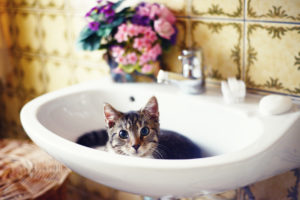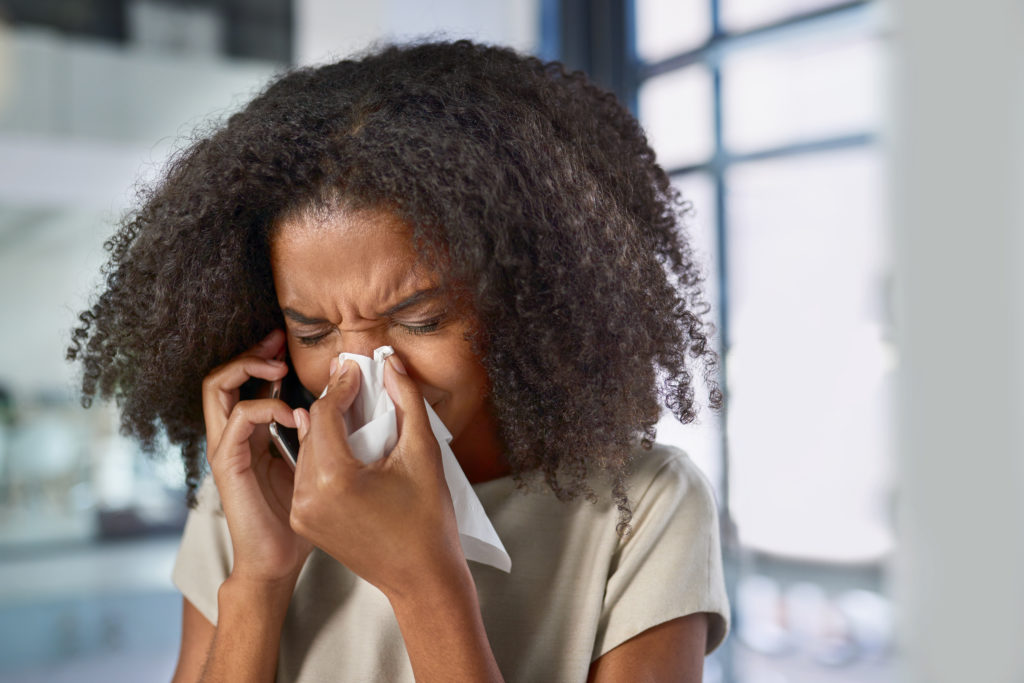Everything we touch is covered in germs. While it’s gross to think about creepy-crawlies, viruses, and bacteria covering every surface, denying that they exist is no use. The good news is most microbes won’t cause us any harm; the bad news is a good amount of bacteria can make you sick.
Most of the items you come into constant contact with are the culprits for our random illnesses. According to National Geographic, a 2011 study by consumer safety organization NSF International found toothbrush holders, sponges, dish rags, kitchen sinks, and pet bowls to be some of the dirtiest and germiest items that can make you sick. And that doesn’t even include the items we touch in the outside world. While no one is recommending we wear a hazmat suit on a daily basis, experts do suggest becoming more aware of the things that breed harmful bacteria so we can keep our immune system in check.
But where exactly do these germs come from in the first place?
Philip Tierno, a pathologist and author of a book called The Secret Life of Germs, told National Geographic that humans produce germs three different ways. One of the biggest germ-producing machines is our very own skin. Our noses and mouths also contain a host of microbes, and the third most common place germs come from is our feces. Gross.
All in all, it’s impossible to try to get rid of all the bacteria in our environment, and some of the bacteria we come into contact with is actually good for us! But, that doesn’t mean we should stop washing our hands, our fruits, or our counters. So if you want to know exactly what items you should clean on a weekly basis to stop the germs from spreading, scroll below, and thank us later.
1. Cell Phones
[fm_giphy url=”https://media.giphy.com/media/6xO2gsP4ma0rC/giphy.gif”]
Unfortunately, the one thing that you always have by your side is kind of dirty.
You use your phone every day, and it never leaves your side (hello, bathroom breaks). Unfortunately, your device is covered with bacteria and germs, which can make you sick.
A 2011 study conducted by London School of Hygiene and Tropical Medicine found fecal matter on every one out of six cell phones.
Plus, USA Today mentions that previous studies have found pathogens, such as Streptococcus, MRSA, and E. coli. on people’s phones. With all of that in mind, experts in a Time article suggest cleaning your phone a few times a month, so as long as you make this your weekly chore, you should be safe.
2. Money
[fm_giphy url=”https://media.giphy.com/media/3o6gDWzmAzrpi5DQU8/giphy.gif”]
You may be rich in germs after handling your cash.
While it’s always a good idea to have cash on hand, you may want to disinfect your hands after touching your dollar bills. According to a 2017 study published in the journal PLOS ONE, researchers swabbed one-dollar bills in New York City and found hundreds of species of microorganisms, while another study found traces of cocaine on almost 80 percent of 10 one-dollar bills.
Luckily, Emily Martin, assistant professor of epidemiology at the University of Michigan School of Public Health, told Time that these microbes aren’t that dangerous to our health.
Still, it’s a good idea to wash your hands at least a few times a day.
3. Kitchen Sponges
[fm_giphy url=”https://media.giphy.com/media/XZLAQ6mYTGzVkleu52/giphy.gif”]
This is one household item that can definitely make you sick.
Yes, this little guy is supposed to clean all the dishes in your house, but it’s also a hotbed for bacteria. In an NPR article, Jennifer Quinlan, a food microbiologist at Drexel University, recommends replacing your sponges every one to two weeks.
Quinlan also suggests keeping them away from raw meat and cleaning them every few days.
You can do this by loading them into the dishwasher with a heated dry cycle or popping the wet sponge in the microwave for a minute. Either way, you don’t want to keep sponges for long, or things can get scary.
4. Grocery Carts
[fm_giphy url=”https://media.giphy.com/media/w9ikCcFzWY0yA/giphy.gif”]
Let’s just say it might be a good idea to wipe these guys down with a disinfectant wipe.
A study was conducted by researchers of the University of Arizona to find out exactly how germy grocery carts can be. After testing 85 random carts across the West Coast, they not only found that most carts have more bacteria than what was measured in over 100 public restrooms, but these carts house some of the nastiest bacteria (i.e. Salmonella, E. coli, Campylobacter).
5. Earbuds
[fm_giphy url=”https://media.giphy.com/media/fGR0wfrAFhkfgV5r7M/giphy.gif”]
Sorry, but your ear’s best friends are kind of nasty.
It’s not your ear’s fault, though. Your ears naturally produce a healthy and totally normal microbial flora. When these microbes mix with your earbuds that have touched every surface known to man, it can lead to some nasty bacteria development. According to Buzzfeed, Kelly Reynolds, Ph.D., associate professor of environmental health at the University of Arizona, said, “Studies have shown that earbuds cause an 11-fold increase in bacteria in the ears.”
Unfortunately, that’s just the beginning.
If you’ve ever shared your headphones with someone, you may want to think again. Reynolds explained, “When you share headphones, you’re doubling the microbial flora in your ears and introducing new bacteria.”
6. Remote Controls
[fm_giphy url=”https://media.giphy.com/media/Mui0OSVNTpj7W/giphy.gif”]
Say hello to your little germy friends.
Your remote control is a breeding ground for germs. According to WebMD, a study and survey from the Hygiene Council found that remote controls are covered with 70 kinds of bacteria per inch. While it’s not as much as toilet bowl (3.2 million bacteria per inch), it’s still pretty nasty if you ask us.
7. Toothbrushes And Toothbrush Holders
[fm_giphy url=”https://media.giphy.com/media/6EpecYmJhUaaUtoC9t/giphy.gif”]
Think your mouth is its cleanest right after you brush? Think again
A study by the National Sanitation Foundation found that most toothbrush holders fall right behind dish sponges and kitchen sinks as being the dirtiest items in a home. If this grosses you out, opt to clean your toothbrush holder almost every other day, make sure to keep it upright, and definitely make sure not to let your toothbrush touch someone else’s. This trick can prevent toothbrushes accidentally swapping germs, which is a must if you don’t want your toothbrush to make you sick.
8. Bags
[fm_giphy url=”https://media.giphy.com/media/SLpN66o4wsuYnWlFNS/giphy.gif”]
A bag that holds everything probably also holds a lot of germs.
The next time you reach into your purse, you may want to wash your hands right after. According to Initial Washroom Hygiene, a hygiene and washroom services company in the U.K., handbags contain enough bacteria to compete with your toilet seat.
But what’s the dirtiest part of the bag itself? Ding, ding, ding — it’s the handle.
To prevent your bag from becoming a germ rodeo, make sure to carefully wash it at least once a week, and keep items that could be damp (i.e. used tissues and food) away at all costs, because your cute bag shouldn’t make you sick.
9. ATMs
[fm_giphy url=”https://media.giphy.com/media/26hpKVNwwm5da1EK4/giphy.gif”]
Take your money, leave with germs.
Hundreds of folks touch ATMs every single day, so you can probably imagine how dirty they can get. Lucky for us, a 2019 study was conducted and found that most NYC ATMs are dirtier than bathroom toilet handles in Penn Station.
The kicker? Researchers also noted that the dirtiest part of the ATM machine was the card reader.
You may want to consider cleaning your debit card while you’re at it.
10. Kitchen Towels
[fm_giphy url=”https://media.giphy.com/media/nIdXs4jUVv6PS/giphy.gif”]
Drying off your hands can make you sick, too.
Yes, kitchen towels are a staple in, well, the kitchen, but they should also be a staple in your weekly laundry as well. After collecting 100 kitchen towels, researchers from the University of Mauritius found that 49 percent were covered with bacteria.
But that’s not all.
If you happen to use a towel for multiple uses (i.e. holding utensils, drying your hands and dishes, etc,), researchers also found that those harbor extra bacteria than your average towel or paper towel.
11. Hand Dryers
[fm_giphy url=”https://media.giphy.com/media/iOyNlpokssmLGaWnl2/giphy.gif”]
Hot air? Yeah, no thanks.
While hot hand dryers are a great way to save the environment, they could actually be making you sick. According to MarketWatch, these little machines are filled with nasty germs and spores and suck up fecal matter that can be released onto your hands.
The difference in germ density between paper towels and hand dryers is staggering.
A study published by the American Society for Microbiology found that bathrooms with hand dryers have 254 pathogens in the air in comparison with bathrooms that only have towels, which just have six pathogens. Gross.
12. Pillowcases
[fm_giphy url=”https://media.giphy.com/media/77FfqFn5tBH8s/giphy.gif”]
Sleep tight and (literally) don’t let the bed bugs bite.
This is one item you’ll touch every single day (and with your entire face and your hair), so it makes sense that it could harbor some pretty gross stuff that can make you sick. Not washing your pillowcases at least once a week can allow oil and bacteria to build up (almost as much as toilet seats!), be a safe haven for dust mites, and — gasp — even allow mold to grow, according to Bustle.
13. Computer Keyboards
[fm_giphy url=”https://media.giphy.com/media/JIX9t2j0ZTN9S/giphy.gif”]
The next time you need to get on your computer, consider disinfecting the keyboard before you touch it.
Why do you ask? Well, research by the University of Arizona found that the average desktop has 400 times more bacteria than the average toilet seat. Let that sink in. The study was conducted in U.S. offices, and it also concluded that women’s keyboards were way dirtier than men’s. Yuck!
14. Vacuum Cleaners
[fm_giphy url=”https://media.giphy.com/media/l2Je1GkjoKoxlDStG/giphy.gif”]
Another cleaning tool bites the dust.
It might be time to buy a whole new vacuum cleaner. According to a study published in journal Environmental Science & Technology, Australian researchers tested 21 different vacuums and found that they all negatively affected the air quality, especially the older models with poor filtration systems. While newer models with HEPA filters are less likely to release dust, bacteria and other pollutants into the air, you may also want to buy an indoor air purifier to cleanse the air as an extra precaution.
15. Showerheads
[fm_giphy url=”https://media.giphy.com/media/12eb3bL2OfwbcY/giphy.gif”]
While you might assume that your shower should be the cleanest area in your home, unfortunately, that’s not the case.
According to New York Post, a study in the journal mBio states that most showerheads (especially from New York, Florida, and Southern California) can be filled with bacteria that could potentially make you sick and lead to a lung infection.
Luckily, the chances of you getting the infection are low unless you have a weakened immune system.
Solution? Clean your entire shower once a week and swap out your metal shower head for a plastic one (to prevent fewer bacteria from growing).





